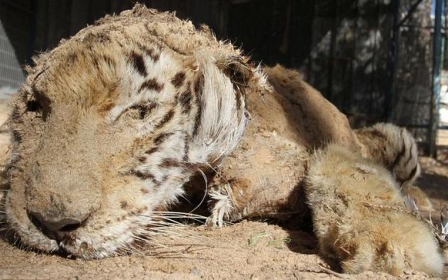IN PICTURES: Displaced Families living behind Banksy Kitten graffiti
The 2 minute video released by unidentified British artist Banksy about the Gaza Strip got immediate international media attention and shed light on the current plight of the Palestinians in the tiny Strip, six months after the ceasefire following the seven-week Israeli military offensive of summer 2014.
The video featured some of his graffiti works that he made in some of the very destroyed parts of the Gaza Strip ; and finished by a sentence written in red on some walls: "If we wash our hands of the conflict between the powerful and the powerless we side with the powerful - we don't remain neutral."
One of the most striking graffiti works is the one of a kitten painted on what seems to be a remaining wall of a destroyed home. Banksy explains on his website his intentions for that graffiti work: "A local man came up and said 'Please - what does this mean?' I explained I wanted to highlight the destruction in Gaza by posting photos on my website - but on the Internet people only look at pictures of kittens."
The graffiti was made in one of the devastated quarters of Beit Hanoun, where several families live around makeshift shelters or metal caravans provided by organisations. Around 100,000 homes were destroyed or heavily damaged during the last Israeli offensive in the summer 2014.
Activestills photographers and Middle East Eye contributors Anne Paq and Basel Yazouri were documenting the life of displaced Palestinians in makeshift shelters when they noticed the kitten graffiti artwork one week before the release of the video.
Their photos describe the lives of the Palestinian families who live just a few metres behind it. They live in extreme poverty and appalling conditions after having lost their homes, like many others, during last summer's Israeli offensive.
The Shabari family lives in just a few square metres of what remains of a destroyed house. They have no money to rent anywhere and the financial aid to rebuild has not come yet. They patched some of the holes in the walls and ceiling with wood and plastic.
Due to lack of space, the mother has to send away some of her children to sleep as the nearby UN-run school turned into a shelter.
Just next to them, other members of the extended Shabari family live in a makeshift shelter made out of wood, plastic and metal. That day, they had no gas left and could not cook warm food.
These are just two examples of the tens of thousands of Palestinians who are still displaced six months after the ceasefire following the 7-week Israeli military assault against the Gaza Strip. Despite the promises of help and allievating the siege, the situation on the ground is disastrous and rebuilding almost non-existent. 30 International Aid Agencies on the same day of the Banksy video released a joint statement, alarmed by the limited progress in rebuilding the lives of those affected and tackling the root causes of the conflict. They unequivocably assessed that the Israeli-imposed blockade continues, the political process, along with the economy, are paralysed, and living conditions have worsened.
The cheerful Banksy kitten seems totally out of place in the grim environment and makes it interesting for international media. The thought-provoking artwork by the famous enigmatic artist brought immediate renewed attention to the plight of the Palestinians in Gaza.
New MEE newsletter: Jerusalem Dispatch
Sign up to get the latest insights and analysis on Israel-Palestine, alongside Turkey Unpacked and other MEE newsletters
Middle East Eye delivers independent and unrivalled coverage and analysis of the Middle East, North Africa and beyond. To learn more about republishing this content and the associated fees, please fill out this form. More about MEE can be found here.




